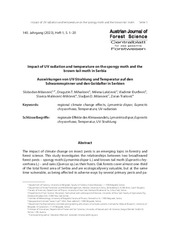Prikaz osnovnih podataka o dokumentu
Impact of UV radiation and temperature on the spongy moth and the brown-tail moth in Serbia
| dc.creator | Milanović, Slobodan | |
| dc.creator | Mihailović, Dragutin | |
| dc.creator | Lakićević, Milena | |
| dc.creator | Đurđević, Vladimir | |
| dc.creator | Malinović-Milićević, Slavica | |
| dc.creator | Milanović, Slađan | |
| dc.creator | Trailović, Zoran | |
| dc.date.accessioned | 2023-07-20T13:08:36Z | |
| dc.date.available | 2023-07-20T13:08:36Z | |
| dc.date.issued | 2023 | |
| dc.identifier.issn | 0379-5292 | |
| dc.identifier.uri | http://rimi.imi.bg.ac.rs/handle/123456789/1312 | |
| dc.description.abstract | The impact of climate change on insect pests is an emerging topic in forestry and forest science. This study investigates the relationships between two broadleaved forest pests – spongy moth (Lymantria dispar L.) and brown-tail moth (Euproctis chrysorrhoea L.) – and oaks (Quercus sp.) as their hosts. Oak forests cover almost one-third of the total forest area of Serbia and are ecologicallyvery valuable, but at the same time vulnerable, as being affected in adverse ways by several primary pests and pathogens. Since 1862, Serbia experienced several extremely large outbreaks of spongy moth with more than a hundred thousand hectares completely defoliated each time, while brown-tail moth occurred periodically with a much lower spatial extent. The aim of this research was to investigate the effect of UV radiation (UVR) and air temperature on spongy moth and brown-tail moth in Serbian forests. We used simulations of the coupled regional climate model EBU-POM (Eta Belgrade University-PrincetonOcean Model) for the A1B scenario for the period 2001-2030 as main input and different statistical methods to explore relationships between observations of pest spread and climate change impacts. Our results suggest: (i) increasing the areas affected by spongy moth due to its sensitivity on UVR in May, and (ii) altitudinal spreading of brown-tail moth population up to 800 – 1000 m. This research indicates that in situ forest observations in Serbia are not only affected by climate change, but also by the combined effect of climate on forest pests. For further research, we recommend exploring other forest stressors or dieback phenomena in European forests by applying the same or similar regional climate model dataset. | |
| dc.language | en | |
| dc.publisher | Osterreichischer Agrarverlag GmbH | |
| dc.relation | info:eu-repo/grantAgreement/MESTD/inst-2020/200169/RS// | |
| dc.relation | info:eu-repo/grantAgreement/MESTD/inst-2020/200172/RS// | |
| dc.relation | info:eu-repo/grantAgreement/MESTD/inst-2020/200117/RS// | |
| dc.relation | info:eu-repo/grantAgreement/MESTD/inst-2020/200015/RS// | |
| dc.rights | openAccess | |
| dc.rights.uri | https://creativecommons.org/licenses/by-sa/4.0/ | |
| dc.source | Forest Science | |
| dc.source | Austrian Journal of Forest Science | |
| dc.subject | regional climate change effects | |
| dc.subject | Lymantria dispar | |
| dc.subject | Euproctis chrysorrhoea | |
| dc.subject | Temperature | |
| dc.subject | UV radiation | |
| dc.title | Impact of UV radiation and temperature on the spongy moth and the brown-tail moth in Serbia | |
| dc.type | article | |
| dc.rights.license | BY-SA | |
| dc.citation.epage | 20 | |
| dc.citation.issue | 1 | |
| dc.citation.spage | 1 | |
| dc.identifier.doi | 10.53203/fs.2301.1 | |
| dc.identifier.fulltext | http://rimi.imi.bg.ac.rs/bitstream/id/2984/bitstream_2984.pdf | |
| dc.type.version | publishedVersion |

